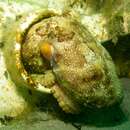mk
имиња во трошки


Octopus pallidus, the pale octopus, is a species of octopus in Oceania.[1]
Immediately after hatching, the pale octopus forages, primarily on bivalves. At night it hides in rubble to surprise prey.[1] Female maturation is dependent on age as well as season.[2] Both sexes can distinguish vertical from horizontal rectangles, and gradient greys from each other and uniform grey.[3]
This species has been studied by scientists trying to determine octopus ages by stylets and pigment.[4][5]
Octopus pallidus, the pale octopus, is a species of octopus in Oceania.
Immediately after hatching, the pale octopus forages, primarily on bivalves. At night it hides in rubble to surprise prey. Female maturation is dependent on age as well as season. Both sexes can distinguish vertical from horizontal rectangles, and gradient greys from each other and uniform grey.
This species has been studied by scientists trying to determine octopus ages by stylets and pigment.
Octopus pallidus est une espèce d'octopodes de la famille des Octopodidae.
Cette espèce est présente dans les eaux du sud-ouest de l'océan Pacifique, en milieu subtropical, dans des eaux situées entre 3 mètres et 589 mètres[3].
Octopus pallidus est une espèce d'octopodes de la famille des Octopodidae.
Il polpo pallido (Octopus pallidus) è un mollusco cefalopode della famiglia Octopodidae, diffuso nelle coste dell'Australia sud-orientale e della Tasmania.
Octopus pallidus is een soort in de taxonomische indeling van de inktvissen, een klasse dieren die tot de stam der weekdieren (Mollusca) behoort. De inktvis komt enkel in zout water voor en is in staat om van kleur te veranderen. Hij beweegt zich voort door water in zijn mantel te pompen en het er via de sifon weer krachtig uit te persen. De inktvis is een carnivoor en zijn voedsel bestaat voornamelijk uit vis, krabben, kreeften en weekdieren die ze met de zuignappen op hun grijparmen vangen.
De inktvis komt uit het geslacht Octopus en behoort tot de familie Octopodidae. Octopus pallidus werd in 1885 beschreven door Hoyle.[1]
Bronnen, noten en/of referenties琶蛸(学名:Octopus pallida)为蛸科蛸属的动物。分布于马来群岛、澳大利亚西部南部、斯里兰卡海域,包括南海等海域,生活环境为海水,一般生活于200 米以内的大陆架底层。其生存的海拔下限为-366米。该物种的模式产地在澳大利亚新南威尔士福尔德湾。[1]
琶蛸(学名:Octopus pallida)为蛸科蛸属的动物。分布于马来群岛、澳大利亚西部南部、斯里兰卡海域,包括南海等海域,生活环境为海水,一般生活于200 米以内的大陆架底层。其生存的海拔下限为-366米。该物种的模式产地在澳大利亚新南威尔士福尔德湾。